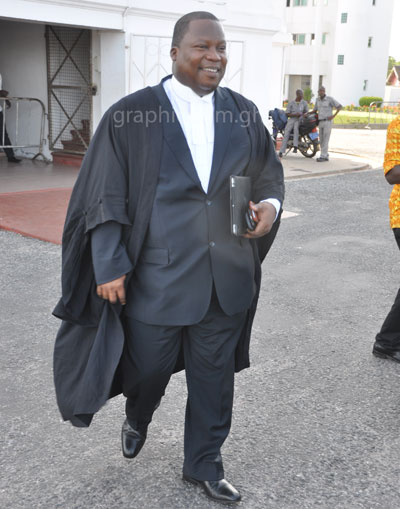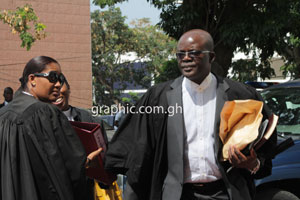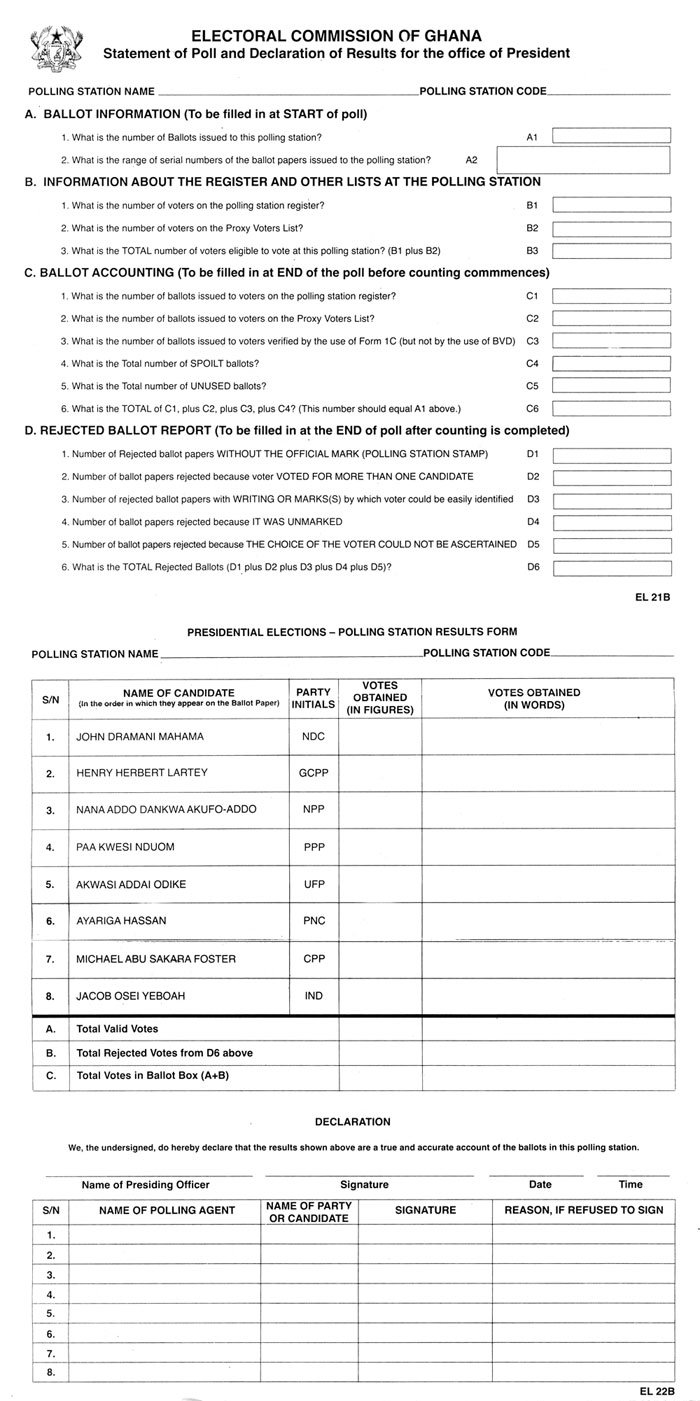Pink sheets reign in Election Petition hearing
 Pink, a watered-down red colour, has been widely associated with affection. In many parts of the world, it is viewed as soft, pleasant and feminine.
Pink, a watered-down red colour, has been widely associated with affection. In many parts of the world, it is viewed as soft, pleasant and feminine.
Advertisement
Pink has varied meanings that cut across politics, fashion, economics, sports and a host of other disciplines.
Universally, the colour pink is associated with girls.
In Ghana, however, pink means serious business. Pink in Ghana’s politics since December 9, 2012 has not meant the same for the two main political parties in the country.
While the presidential candidate of the National Democratic Congress (NDC), President John Dramani Mahama, benefited from the colour pink on December 9, 2012, the same cannot be said of the presidential candidate of the New Patriotic Party (NPP), Nana Addo Dankwa Akufo-Addo.
Results collated on pink sheets and subsequently declared by the Chairman of the Electoral Commission (EC), Dr Kwadwo Afari-Gyan, inured to the benefit of President Mahama, but Nana Akufo-Addo and two others, per their arguments, see the pink sheets from 11,138 polling stations as “tainted” with gross and widespread irregularities and not fit to be added to the tally of polls declared.
Nana Akufo-Addo, his running mate, Dr Mahamadu Bawumia, and the Chairman of the NPP, Mr Jake Otanka Obetsebi-Lamptey, are challenging the declaration of President Mahama as winner of the 2012 presidential election based on the pink sheets in their possession.
And aside from the general reference to rules of court, statutes, reported legal cases and the1992 Constitution, lawyers on all the sides have relied heavily on the pink sheets to make their case.
Sittings at the Supreme Court for the past 22 days have been heavily characterised by objections and counter-objections relating to both filed and unfiled pink sheets.
The expression “pink sheet” has become so popular that it can hardly “pass by” without it being caught up in all manner of conversations in Ghana.
When the Supreme Court resumes its sitting today, it will be the pink sheets that will again take centre stage.
The international auditing firm, KPMG, will also be expected to submit its findings to the Supreme Court on the number of pink sheets submitted by the petitioners this week.
The Pink Sheet?

The form on which the Statement of Poll and Declaration of Result for the office of President and Parliament is recorded is known as the pink sheet.
It is called pink because it is coloured pink.
For the purpose of this article, the focus will be on the Statement of Poll and Declaration for the office of President.
Article 49 (2) of the 1992 Constitution states: “Immediately after the close of poll, the presiding officer shall, in the presence of such candidate or their representatives and their polling agents as are present, proceed to count, at the polling station, the ballot papers of that station and record the votes cast in favour of each candidate or question.”
‘Question’ here refers to the event a referendum is being organised and polls have closed for counting to proceed.
Article 49 (3) states: “The presiding officer, the candidate or their representative and, in the case of a referendum, the parties contesting or their agents and the polling agents if any, shall then sign a declaration stating – (a) the polling station; and (b) the number of votes cast in favour of each candidate or question: and the presiding officer shall, there and then, announce the results of the voting at the polling station before communicating them to the returning officer.”
Thus, the declaration as spelt out by the Constitution is recorded on the pink sheet, a copy of which is then handed over to representatives of the political parties.
Pink Sheets in the custody of the petitioners
There are currently 26,002 polling stations across the country and, according to the petitioners, 11,138 of the pink sheets from 11,138 polling stations contain irregularities of over-voting, persons voting without undergoing biometric verification, some presiding officers failing to sign pink sheets and some po
lling stations having the same serial numbers.
The petitioners are, therefore, praying the Supreme Court to annul 4.3 million votes cast in those polling stations.
History of Pink Sheets
The pink sheets were white in colour  until 2008 when they were printed in blue.
until 2008 when they were printed in blue.
In the past, pink sheets were issued to political party representatives on A4 sheets, but due to the tendency of their being forged, the EC, in December 2008, introduced the carbonised pink sheets as a security measure.
The carbonised copies were also used in the 2012 elections. These copies are issued to all political parties in carbonised formats, thereby making it impossible for any political party to falsify them.
Nine carbonised pink sheets in 2012 elections
The number of presidential candidates in the 2012 presidential election was eight and for that matter the EC issued nine carbonised copies — the original for the EC and the remaining eight for representatives of the various presidential candidates.
The presidential candidates in the 2012 general election were President Mahama of the NDC, Dr Henry Herbert Lart
ey of the Great Consolidated Popular Party (GCPP), Nana Akufo-Addo of the NPP and Dr Paa Kwesi Nduom of the Progressive People’s Party (PPP).
Mr Akwasi Addai Odike of the United Front Party (UFP), Mr Hassan Ayariga of the People’s National Convention (PNC), Dr Michael Abu Sakara Foster of the Convention People’s Party (CPP) and Mr Jacob Osei Yeboah, an independent candidate, added to the number of presidential candidates.
General Outlook of a Pink Sheet
A typical pink sheet has the name of the EC clearly embossed on it and has the Coat of Arms also embossed at the top left corner, with a serial
number at the top right corner.
The sheet has spaces for polling station name and code and has been segmented into EL 21 B and EL 22 B.
The EL 21 B column is segmented into Sections A to D.
Section A1 to A2 requires ballot information. Under this section, the presiding officer is expected to answer questions such as: “What is the number of ballots issued to this polling station and what is the range of serial numbers of the ballot papers issued to the polling station?”
Section B is on information on the register and the other lists at the polling station.
Thus B1 to B3 requires the number of voters on the polling station register, the number of voters on the proxy voters list and the total number of voters eligible to vote at a particular polling station.
Proxy voters are those who give the power of attorney to other persons to vote on their behalf due to their inability to be present on voting day at the polling stations where they registered.
Section C is about Ballot Accounting (to be filled in at the end of the poll before counting commences).
Under the C column, C1 to C6 demands information on the number of ballots issued to voters on the polling station register, the

number of ballots issued to voters on the proxy voters list, the number of ballots issued to voters verified by the use of Form 1C (but not by the use of BVD), number of spoilt ballots, number of unused ballots and the total
of C1, C2, C3 and C4 (this number should equal A1 above).
Section D – Rejected ballot report to be filled in at the end of poll after counting is completed
The D column is marked D1 to D6 and it includes the number of rejected ballot papers without official polling station stamp, rejected ballots because a voter voted for more than one candidate, rejected ballot papers with writing or marks by which voter could be easily identified, ballot papers rejected because they were unmarked, ballot papers rejected because the choice of the voter could not be ascertained and the total number of rejected ballots (D1 plus D2 plus D3 plus D4 plus D5).
Second Part of Pink Sheet
The second portion of the pink sheet contains the full names of the presidential candidates and the order in which they appear on the ballot paper.
It also has a space for the polling station name and polling station code and has a major heading: “Presidential Elections – Polling Station Results Form”.
Beneath this heading are the names of the presidential candidates and the political parties they represent.
An independent candidate is also referred to in that capacity.
Next to the party initials are allotments for votes obtained in figures and in words.
Slots are also provided for the total valid votes, total rejected votes and total votes in ballot box to be recorded.
Declaration
Under the Declaration section is a standard statement which says, “We, the undersigned, do hereby declare that the results shown above are a true and accurate account of the ballots in this polling station.”
A space is made available for the Presiding officer and the polling agents of the various presidential candidates to state their names,the name of the party candidate and signature.
An additional slot for party agents to state the reason for their refusal to sign is also provided on the pink sheet.
The fight over pink sheets
The issue relating to pink sheets is so delicate that the parties in the case are currently in disagreement over the actual number of pink sheets submitted to the Supreme Court Registry.
Lawyers for the President and the NDC, in a letter dated May 21, 2013 and addressed to KPMG, the audit firm appointed by the Supreme Court to audit the pink sheets, alleged that 10 additional boxes have been added to 24 already inspected boxes.
“It is our opinion that the ten boxes that were not part of those inspected on May 16, 2013 ought to be identified, isolated and excluded, as they are not part of the subject matter of the court order on May 9, 2013,” the letter, signed by Mr Tony Lithur and Mr Samuel Codjoe, lawyers for President Mahama, stated.
Lawyers for the petitioners, on the other hand, have vehemently opposed the allegations of the respondents.
For instance, a former Deputy Attorney-General and Minister of Justice, Ms Gloria Akuffo, has denied respondents’ claims and described them as totally false.
Mr Philip Addison also stated in open court that the allegations by the two respondents were part of their many cooked up stories and must, therefore, be ignored with impunity.
The Position of the Court and Referee KPMG
The nine-member Supreme Court panel, comprising Mr Justice William Atuguba, as President, Mr Justice Julius Ansah, Mrs Justice Sophia Adinyira, Ms Justice Rose Owusu, Mr Justice Jones Dotse, Mr Justice Annin Yeboah, Mr Justice Paul Baffoe-Bonnie, Mr Justice N. S. Gbadegbe and Mrs Justice Vida Akoto-Bamfo, has affirmed its decision in giving the KPMG the green light to audit the pink sheets submitted to the court’s registry by the petitioners on April 7, 2013.
It has, however, urged the auditors to officially note down any complaint from any of the parties in the final report.
Meanwhile, the auditing of the pink sheets, which is being done in the presence of representatives of parties in the petition, is ongoing.
Pink Sheet Analysis
The respondents have accused Dr Bawumia, the star witness for the petitioners, of deliberately duplicating pink sheets in order to deceive the court, but Dr Bawumia, during his 21 days of evidence-in-chief, cross-examination and re-examination, maintained that he used single pink sheets in his final analysis and that at no point did he repeat any pink sheet in the analysis.
The Court and Issues for Consideration
The court will take into account evidence adduced by the parties and their witnesses and the laws of the country before arriving at its final decision.
It has, in the meantime, narrowed down two issues for determination — whether or not statutory violations, omissions, malpractices and irregularities occurred during the conduct of the elections held on December 7 and 8, 2012 and also ascertain whether or not the said violations, omissions, irregularities and malpractices (if any) affected the outcome of the results.
Keep fingers crossed on pink sheets
The pink sheet has demonstrated its importance in Ghana’s politics because information on it has the power to determine who wins an election.
Story: Mabel Aku Baneseh
Writer’s e-mail: [email protected]
Below is a sample of the pink sheet



